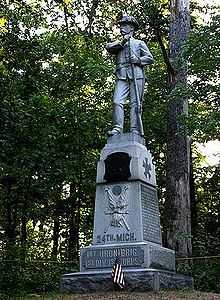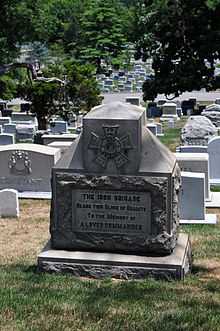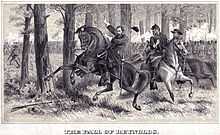Iron Brigade


The Iron Brigade, also known as the Iron Brigade of the West or the Black Hat Brigade, was an infantry brigade in the Union Army of the Potomac during the American Civil War. Although it fought entirely in the Eastern Theater, it was composed of regiments from Western states (states that are today considered Midwestern). Noted for its strong discipline, its unique uniform appearance, and its tenacious fighting ability, the Iron Brigade suffered the highest percentage of casualties of any brigade in the war.
The nickname "Iron Brigade", with its connotation of fighting men with iron dispositions, was applied formally or informally to a number of units in the Civil War and in later conflicts. The Iron Brigade of the West was the unit that received the most lasting publicity in its use of the nickname.
Brigade nickname
The Iron Brigade initially consisted of the 2nd, 6th, and 7th Wisconsin Volunteer Infantry Regiments, the 19th Indiana, Battery B of the 4th U.S. Light Artillery, and was later joined by the 24th Michigan. This composition of men from three Western states led it to be sometimes referred to as the Iron Brigade of the West. They were known throughout the war as the Black Hats because of the black 1858 model Hardee hats issued to Army regulars, rather than the blue kepis worn in most other units.
The all-Western brigade earned its famous nickname while under the command of Brig. Gen. John Gibbon, who led the brigade in its first battle. On August 28, 1862, during preliminary phases of the Second Battle of Bull Run, it stood up against attacks from a superior force under Maj. Gen. Thomas J. "Stonewall" Jackson on the Brawner farm. The designation "Iron Brigade" is said to have originated during the brigade's action at Turners Gap, during the Battle of South Mountain, a prelude to the Battle of Antietam in September 1862. Maj. Gen. Joseph Hooker, commanding I Corps, approached Army of the Potomac commander Maj. Gen. George B. McClellan, seeking orders. As the Western men advanced up the National Road, forcing the Confederate line all the way back to the gap, McClellan asked, "What troops are those fighting in the Pike?" Hooker replied, "[Brigadier] General Gibbon's brigade of Western men." McClellan stated, "They must be made of iron." Hooker said that the brigade had performed even more superbly at Second Bull Run; to this, McClellan said that the brigade consisted of the "best troops in the world". Hooker supposedly was elated and rode off without his orders. There are a few stories related to the origin, but the men immediately adopted the name, which was quickly used in print after South Mountain.[1]
Brigade history

The unit that became known as the Iron Brigade was activated on October 1, 1861, upon the arrival in Washington, D.C., of the 7th Wisconsin. It was combined into a brigade with the 2nd and 6th Wisconsin, and the 19th Indiana, under the command of Brig. Gen. Rufus King . The governor of Wisconsin, Alexander Randall, had hoped to see the formation of an entirely Wisconsin brigade, but the Army unwittingly frustrated his plans by transferring the 5th Wisconsin from King's brigade and including the Hoosiers instead.[2] This brigade was initially designated the 3rd Brigade of Maj. Gen. Irvin McDowell's division of the Army of the Potomac, and then the 3rd Brigade, I Corps.[3]
McDowell's I Corps did not join the bulk of the Army of the Potomac in the Peninsula Campaign. In June 1862 it was redesignated the III Corps of Maj. Gen. John Pope's Army of Virginia. Now under the command of John Gibbon, a regular Army officer from North Carolina who chose to stay with the Union,[4] King's brigade was designated the 4th Brigade, 1st division, III Corps, and it saw its first combat in the Northern Virginia Campaign. Almost immediately following the Union defeat in the Second Battle of Bull Run, the III Corps was transferred back to the Army of the Potomac and redesignated the I Corps, under the command of Joseph Hooker; Gibbon's brigade became the 4th Brigade, 1st Division, I Corps.
The 24th Michigan joined the brigade on October 8, 1862, prior to the Battle of Fredericksburg in December. On February 27, 1863, the brigade, now under the command of Brig. Gen. Solomon Meredith, was redesignated the 1st Brigade, 1st Division, I Corps.
The brigade commanders, disregarding temporary assignments, were:
- Brig. Gen. Rufus King: September 28, 1861 – May 7, 1862
- Brig. Gen. John Gibbon: May 7, 1862 – November 4, 1862
- Brig. Gen. Solomon Meredith: November 25, 1862 – July 1, 1863 (wounded at Gettysburg)
The Iron Brigade lost its all-Western status on July 16, 1863, following its crippling losses at Gettysburg, when the 167th Pennsylvania was incorporated into it. However, the brigade that succeeded it, which included the survivors of the Iron Brigade, was commanded by:
- Col. William W. Robinson (of the 7th Wisconsin): July 1, 1863 – March 25, 1864
- Brig. Gen. Lysander Cutler (6th Wisconsin): March 25, 1864 – May 6, 1864
- Col. William W. Robinson: May 6, 1864 – June 7, 1864
- Brig. Gen. Edward S. Bragg (6th Wisconsin): June 7, 1864 – February 10, 1865
- Col. John A. Kellogg (6th Wisconsin): February 28, 1865 – April 27, 1865
- Col. Henry A. Morrow (24th Michigan): April 27, 1865 – June 5, 1865
In June 1865, the units of the surviving brigade were separated and reassigned to the Army of the Tennessee.
The brigade fought in the Second Bull Run, Antietam, Fredericksburg, Chancellorsville, Gettysburg, Mine Run, Overland, Richmond-Petersburg, and Appomattox campaigns.
The brigade took pride in its designation, "1st Brigade, 1st Division, I Corps", under which it played a prominent role in the first day of the Battle of Gettysburg, July 1, 1863. It repulsed the first Confederate offensive through Herbst's Woods, capturing much of Brig. Gen. James J. Archer's brigade, and Archer himself. The 6th Wisconsin (along with 100 men of the brigade guard) are remembered for their famous charge on an unfinished railroad cut north and west of the town, where they captured the flag of the 2nd Mississippi and took hundreds of Confederate prisoners.[5]
The Iron Brigade, proportionately, suffered the most casualties of any brigade in the Civil War. For example, 61% (1,153 out of 1,885) were casualties at Gettysburg. Similarly, the 2nd Wisconsin, which suffered 77% casualties at Gettysburg, suffered the 3rd highest total throughout the war; it was third behind the 24th Michigan (also an Iron Brigade regiment) as well as the 1st Minnesota in total casualties at Gettysburg. The Michigan regiment lost 397 out of 496 soldiers, an 80% casualty rate. The 1st Minnesota Regiment actually suffered the highest casualty percentage of any Union regiment in a single Civil War engagement during the battle of Gettysburg losing 216 out of 262 men (82%).
Other Iron Brigades
There have been other brigades known by the same nickname. Use of the Iron Brigade name is not taken lightly in the U.S. Army, and the present-day units that have taken Iron Brigade as their nickname have proven themselves in battle as worthy to hold the name.
- Another brigade in the Army of the Potomac had previously been known as the Iron Brigade (later the Iron Brigade of the East or First Iron Brigade to avoid confusion). This unit was the 1st Brigade, 1st Division, I Corps, prior to Meredith's brigade getting that designation. It consisted of the 22nd New York, 24th New York, 30th New York, 14th Regiment (New York State Militia), and 2nd U.S. Sharpshooters. Although this Iron Brigade of the East served in the same infantry division as the Iron Brigade of the West, press attention focused primarily on the latter. Most of the Eastern regiments were mustered out before the Battle of Gettysburg, where the remaining Eastern Iron Brigade Regiments and the Iron Brigade of the West arguably achieved their greatest fame.
- A Confederate cavalry brigade was known as Shelby's Iron Brigade. It was in the division commanded by Brig. Gen. Joseph O. (Jo) Shelby in the Army of Missouri and fought in Maj. Gen. Sterling Price's Missouri Expedition in 1864.
- Recent scholarship[6] identifies two other brigades referred to by their members or others as "The Iron Brigade":
- 3rd Brigade, 1st Division, III Corps (17th Maine, 3rd Michigan, 5th Michigan, 1st, 37th, and 101st New York)
- Reno's Brigade from the North Carolina expedition (21st and 35th Massachusetts, 51st Pennsylvania, and 51st New York)
- The 2nd Brigade of the U.S. Army's 1st Armored Division has carried the Iron Brigade moniker since 1985 and was previously called the "Black Hat" Brigade.
- The 3rd Brigade Combat Team, 1st Infantry Division was known as the Iron Brigade from its formation in 1917 through World War I, World War II and Vietnam until some time in the early 2000s when, for reasons that are still unclear, the name was changed to Duke Brigade. The unit crest was an Iron Cross in a triangle, it appears that that was also changed.
- The 3rd Brigade of the 4th Infantry Division is also known as the Iron Brigade. Its unit crest is similar to the medals issued to veterans of the both Western and the Eastern Iron Brigades of the Army of the Potomac.[7]
- The 1st Heavy Brigade Combat Team of the 2nd Infantry Division (United States) is known as the Iron Brigade as well. Located at Camp Casey Korea, the brigade has a critical role of military deterrence on the Korean Peninsula.
- The 2nd Brigade of the 3rd Armored Division (Spearhead), formerly stationed on Coleman Kaserne in Gelnhausen, Germany.
- The 157th Maneuver Enhancement Brigade, also known as the Iron Brigade, is based out of Milwaukee, Wisconsin. It was formerly known as the 57th Field Artillery Brigade, at which time its subordinate organizations included the 1st Battalion, 126th Field Artillery Regiment and the 1st Battalion, 121st Field Artillery Regiment from the Wisconsin Army National Guard, plus the 1st Battalion, 182nd Field Artillery Regiment of the Michigan Army National Guard. Not to be confused with the famous "Iron Brigade" of the Civil War, the 57th Field Artillery Brigade is also known as the "Iron Brigade," a nickname traditionally given to crack artillery units in the Civil War. It was during World War I that the 57th Field Artillery Brigade earned its nickname as it spent many hours at the front and fired more artillery rounds than any brigade in the American Army.
- The 32nd Infantry Division was an infantry division of the United States Army National Guard that fought primarily during World War I and World War II. It was formed with units from the states of Wisconsin and Michigan. With roots as the Iron Brigade in the American Civil War, the division's ancestral units came to be referred to as the Iron Jaw Division.
- The name "Iron Brigade" has also been used to describe the offensive line of the University of Wisconsin Badger Football Team. The line is known for its size, strength, and dedication to the protection of the backfield. The Badgers play in Camp Randall Stadium, a site used to train Wisconsin volunteers during the Civil War.
Notes
- ↑ Herdegen, p. 244.
- ↑ Nolan, p. 28.
- ↑ Eicher, p. 334.
- ↑ Dorsey, p.50.
- ↑ Herdegen, Beaudot, p. 207.
- ↑ Clemens, Tom, Will the Real Iron Brigade Please Stand Up? (August 2000 presentation to the Richmond, Virginia, Civil War Round Table.)
- ↑ See unit crest illustration at GlobalSecurity.org
References
- Beaudot, William J. K., and Herdegen, Lance J., In the Bloody Railroad Cut at Gettysburg, Morningside, 1990, ISBN 0-89029-535-7 .
- Dorsey, Chris "Of Iron and Stone: A Comparison of the Iron and Stonewall Brigades," The Journal of America's Military Past, (Winter, 2001); 48-67.
- Eicher, John H., and Eicher, David J., Civil War High Commands, Stanford University Press, 2001, ISBN 0-8047-3641-3.
- Fox, William F., Regimental Losses in the American Civil War, reprinted by Morningside Bookshop, Dayton, Ohio, 1993, ISBN 0-685-72194-9.
- Herdegen, Lance J., The Men Stood Like Iron: How the Iron Brigade Won Its Name, Indiana University Press, 1997, ISBN 0-253-33221-4.
- Nolan, Alan T., The Iron Brigade, A Military History, Indiana University Press, 1961, ISBN 0-253-34102-7.
Further reading
- Herdegen, Lance J., Those Damned Black Hats! The Iron Brigade in the Gettysburg Campaign, Savas, 2008, ISBN 978-1-932714-48-7.
- Wert, Jeffry D., A Brotherhood of Valor: The Common Soldiers of the Stonewall Brigade, C.S.A., and the Iron Brigade, U.S.A., Touchstone, 1999, ISBN 978-0-684-86244-6.